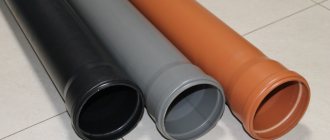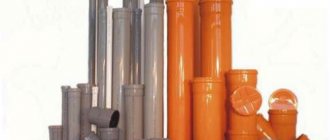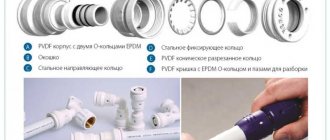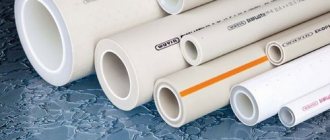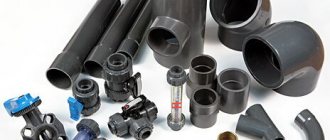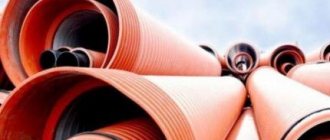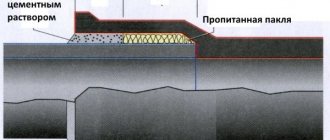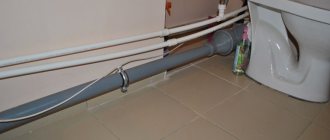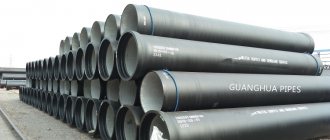Pipes made of low-density polyethylene (HDPE) can be of various colors, with or without markings. As for the technical pipe, in most cases it is black. Non-pressure black HDPE pipe has found wide application in the construction and repair of communications. Technical black pipes are indispensable when laying cables inside buildings and underground: they can withstand high loads, are an excellent insulator and prevent condensation. In addition, a large diameter black HDPE pipe is suitable for creating a free-flow sewer system.
You can buy a black polyethylene pipe directly from the factory. At your request, the pipe will be cut into the required lengths or wound onto a coil of the required length. The price of a black pipe per meter or kg depends on the volume, but no matter how many meters you order, the cost will be the most favorable on the Russian market.
Black plastic pipe - saving and ecology.
Saving.
HDPE stands for “low-density polyethylene”. This material for pipe production has a number of advantages over metal and other types of plastic. Technical HDPE pipes are designed for cable laying and drainage, that is, for non-pressure purposes. The black plastic pipe for electrical cables and sewerage resembles a hose in appearance, although it does not have the same elasticity. At the same time, it is rigid enough to withstand static and dynamic loads.
We sell non-pressure black pipes with smooth walls. Their undeniable advantages include low price, ease of installation, corrosion resistance and long service life. When metal sewer pipes freeze in winter, ruptures occur, but the HDPE pipe, when frozen, only stretches a little and then restores its shape. There are huge savings on winter pipe repairs.
In addition, savings during laying and installation due to reduced costs for transportation, lifting, installation, cost, etc. distinguish them favorably in comparison with metal pipes.
Ecology.
The environmental aspects of using black HDPE pipes deserve more detailed coverage. Firstly, such pipelines are immune to the destructive effects of moisture and soil bacteria for more than 50 years. Secondly, this type of pipe immediately gained huge demand in the construction of underwater pipelines (especially for laying cables). Installation of flexible pipes is carried out on the shore, and then unwinding it along the bottom is not difficult. HDPE does not have a noticeable harmful effect on the surrounding water, but the use of non-pressure pipe options for drinking water is prohibited. The third environmentally important property is that HDPE is recyclable; in addition, the walls of free-flow pipes completely decompose after a few hundred years (unlike plastic bottles, which already float in huge islands in the oceans). Naturally, not even a hundred years have passed since the discovery of this material, but this has already been calculated by experts.
Green pipes
Pipes used for drainage are painted green (sometimes blue). A distinctive feature is the ability to bend and withstand strong pressure from the soil settling on top.
Since the product is used in the external environment, the material can easily withstand temperature fluctuations, as well as its decrease to negative values. There may be perforations on the walls, which allows water to penetrate inside. Some manufacturers equip their products with a geotextile filter.
Let's summarize. Gray pipes are suitable for home use; if the sewage system goes into the ground, then in this place it is advisable to switch to orange pipes. Whites have the same properties as grays, but are more attractive in appearance. Black ones are larger in size and are used for laying city sewerage. Green ones are used for drainage.
When choosing pipes, the main attention should be paid to the material of manufacture and its properties. They must be suitable for future operating conditions, otherwise the service life of the products will be significantly reduced.
Black HDPE pipe for electrical cable.
An electrical cable requires reliable protection from precipitation, dampness, and the touch of animals and people. But this protection should not create insurmountable difficulties during installation; in addition, the low price is welcome. All these requirements are best met by black HDPE pipe of small diameters. Their good flexibility makes it easy to lay cables along the walls of houses, underground, above suspended ceilings and in other hard-to-reach places. And the affordable price of black HDPE pipe makes it possible to create communications where previously it was impractical.
The dielectric strength of HDPE pipes is at least 2000V and the highest resistance to temperature changes provide an excellent degree of insulation from adverse environmental factors. Low flammability is considered a very important property for laying cables. This is not to say that such pipes do not burn at all, but the risk of fire is minimized: at a critical temperature they simply melt. In addition, HDPE pipes are completely chemical resistant and do not corrode underground or outdoors.
Polyethylene black pipe for optical cable.
For an optical cable, in addition to the above-mentioned dangers, protection from moisture is very important. The polyethylene black cable pipe is designed to provide complete protection even when laid through bodies of water, not to mention underground networks. Good thermal insulation properties prevent condensation. Elastic walls provide good protection against mechanical stress and other adverse environmental factors. Laying of optical cable is often carried out in inconvenient natural conditions (mountains, reservoirs, uneven terrain, etc.) where access for special equipment is difficult. In such conditions, light weight of pipes and maximum ease of installation are of great importance.
Black sewer pipe.
Black free-flow HDPE pipes are prohibited from being used in water supply systems, but not because of their harmful effects on water, but because of their low resistance to internal pressure. They are not designed to operate under high pressure, which is found in gas and liquid transportation systems. But the use of HDPE pipes in all situations where non-pressure supply or discharge of water is required is justified. They are most often used in sewer and drainage systems. Traditionally, a larger diameter pipe is used for sewerage than for laying cables (from 110 mm). According to recent studies, flexible non-pressure polyethylene pipes have become the undisputed leaders among sewer pipes made from other materials. Moreover, sewer pipes made from other materials will soon cease to be produced altogether.
Why does such a pipe attract consumers? First of all, it is ease of installation and installation. Secondly, low cost and durability. Private households are happy to buy black sewer pipes for all needs that require water removal without the use of pumps. Depressurization of metal sewer pipes occurs most often for three reasons: displacement at the joints as a result of soil subsidence, freezing and corrosion damage. All these aspects are completely eliminated when using elastic HDPE pipes, which are absolutely resistant to corrosion and temperature changes. To install such pipelines, no special skills are required, and the only additional equipment is compression fittings. And finally, the extremely low price of black sewer pipes gives an undeniable appeal.
Smooth sewer gray and white pipe
Pipes of this color are used for internal sewerage. They have good thermal insulation and sound insulation. Standard diameters are 32, 40, 50, 110, 125 and 150 mm, lengths are 150, 250, 500, 1000, 1500, 2000 and 5000 mm. Layer thickness = 2.7 mm.
The tightness of their connection is achieved thanks to the socket and rubber ring inside.
Withstands temperatures up to 95 degrees.
Therefore, these pipes can be used for high temperature drainage. In everyday life these are dishwashers and washing machines. Acids and chemicals also do not affect them.
Due to these characteristics, they are ideal for the internal sewerage system of houses.
In addition, they have a centimeter scale on their surface to make installation faster and more convenient.
Advantages of PE pipes over metal pipes.
- A metal pipe bursts at the slightest mechanical deformation (subsidence of the house or soil, freezing, etc.). Black PE pipes can easily stretch up to 7%; moreover, after defrosting, the diameter returns to its original dimensions. Therefore, rupture of a polyethylene pipe is less likely than a metal pipe (of course, without damage from cutting objects).
- Resistant to corrosion and chemical influences.
- Long service life - more than 50 years, which has already been confirmed in Japan.
- Polyethylene pipelines do not require cathodic or any other protection.
- Low thermal conductivity minimizes the formation of condensation on the external or internal surface of the pipe (especially important for laying cables).
- The extreme ease of installation coupled with the affordable cost of the black pipe significantly saves your budget.
- Reduced formation of mineral deposits on the inner surface of sewer pipes.
- Light weight and, accordingly, ease of transportation and delivery to hard-to-reach places. Due to the fact that black PE pipe is 7 times lighter than metal pipe of the same diameter, it is very convenient for construction in multi-story buildings. In this case, no special lifting mechanisms are required, and one vehicle can deliver a larger number of pipes to the site. All this greatly reduces costs.
- The seams of the connections do not separate throughout the entire service life.
- HDPE pipes allow repeated reinstallation and repair without special material and labor costs.
Black smooth HDPE pipe - easy cable installation.
Laying cables in buildings requires a large number of bends, tight fastening to the surface and good protection from mechanical damage. Smooth black HDPE pipe is indispensable when laying utilities, installing video surveillance networks, alarm systems, etc. Laying flexible pipes is very easy, both indoors and on the external walls of buildings. Light pipes are very easy to lift to a height using only ladders. The use of smooth HDPE pipes guarantees complete protection of the cable from all adverse influences, in addition, a high level of safety is ensured in terms of insulating electrical wires from people. The walls of the pipes are resistant to temperature and provide the proper level of fire safety for electrical wiring.
Electricians enjoy the lightness and flexibility of the pipes, which can be quickly installed and fastened together. Pulling cables along them is also not difficult. When setting up networks, there are often situations when the cable is stretched incorrectly, resulting in it not being enough. You have to re-tighten the entire cable, which damages the walls and ceilings. If the cable was pulled inside HDPE pipes, then re-tensioning it is not a problem - it takes just a minute. It is very convenient that such pipes can be laid at smooth angles or with a large number of bends. The walls are connected using light welding equipment. When welded, the joint becomes monolithic, so seam divergence is an extremely rare occurrence.
Gray pipes
They are used indoors, where there is no strong mechanical and temperature influence. The manufacturing material is polypropylene. Gray pipes are designed for the temperature of the liquid passed through them within 60-75 degrees. However, they can withstand a short-term increase in the indicator to 90-95 degrees. The external temperature should not fall below 0°.
They are characterized by chemical inertness: there are no corrosive processes and no release of harmful substances.
Since deformation occurs with a relatively small force - 50-75 kgf/m2, it is not recommended to install such pipes in places where external pressure will be exerted on them. Use for external sewerage is justified only by financial savings, which, however, may result in the need to dig a trench and replace the entire drain.
Seamless black pipe in coils and meters.
We sell products both in coils and by the meter. Pipes laid in coils are much easier to transport and deliver to the right places. In addition, the benefit of buying pipes in coils is that it is difficult to calculate in advance all the lengths of the sections that may be required; it is much more convenient to cut the pipe on site. When installing communications, a feature of a seamless black pipe is revealed: its walls are absolutely smooth, which is extremely convenient when pulling cables.
But the thicker the pipe, the more difficult it is to wind it into a coil, so we also sell pipes by the meter. If you need to purchase pipes of large diameters, then a more profitable way would be to measure all the lengths in advance and then order cutting from us. We produce pipes in a wide range of diameters and this range is constantly increasing. In addition to the diameter, pipes differ in wall thickness and purpose. Pipes with diameters of 20 mm, 25 mm, 32 mm, 40 mm, 50 mm, 63 mm and 75 mm are often sold in coils, and with a diameter above 75 mm in sections, since it bends poorly and breaks faster when bent. The pipe wall can be different, depending on the needs of the customer.
Criterias of choice
The color division of pipes is used to simplify the choice of variety for certain operating conditions. So, when choosing, you should consider the following criteria:
- The place where the pipes will be laid is an apartment or a private house. Accordingly, the presence or absence of soil pressure is taken into account, which depends not only on its volume, but also on the future location on the surface of the road, vehicle parking, etc.
- Weather conditions in the current region, in terms of soil freezing depth.
- Operating temperature range.
Now let's look at the characteristics and purpose of pipes of different colors in order to easily cope with their choice.
Black pipe from the manufacturer – import substitution in action.
It is much more profitable to buy all goods directly from the manufacturer, since intermediaries inflate prices and have a worse understanding of the characteristics of the product. The production of PE pipes near Moscow minimizes the cost of delivery throughout Moscow and the Moscow region.
Pipes from Western manufacturers are of good quality, but they scare the domestic buyer a little with their exorbitant prices. PE pipes made in China are very cheap, but they fail too quickly. In such a situation, it’s time to pay attention to the products of a domestic manufacturer, which maintains high quality but does not inflate the price. This is real import substitution in action.
We produce black smooth polyethylene pipes in compliance with all standards and, if the customer wishes, we can provide a full package of documentation. High quality products are guaranteed by our specialists and proven technology. Another important advantage of working directly with the manufacturer is the ability to order pipes of non-standard thickness and diameter. If you pay additionally (or order a large volume), we produce pipes according to any customer specifications.
Before purchasing a pipe, you can get competent advice from our specialists on any issue (this point is always much more difficult for intermediaries to carry out, because they are simply not aware of all the details). Black polyethylene pipes are sold from the warehouse. Delivery is carried out in Moscow on the day of order (if in stock), and to other cities of Russia from one day.
We always take into account the buyer's situation and try to organize delivery in the form most convenient for the client. Both wholesale and retail sales are possible. Each client receives individual work and consultation on all issues of interest. Call us, we are ready for fruitful cooperation!
